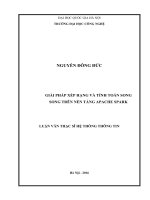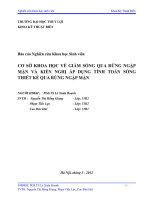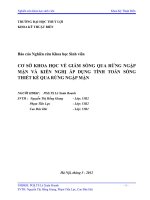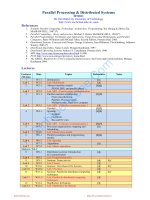tính toán song song thoại nam distributedsystem 15 communication sinhvienzone com
Bạn đang xem bản rút gọn của tài liệu. Xem và tải ngay bản đầy đủ của tài liệu tại đây (755.08 KB, 36 trang )
om
.C
nh
Vi
en
Zo
ne
Distributed Systems
Thoai Nam
Si
Faculty of Computer Science and Engineering
HCMC University of Technology
SinhVienZone.com
/>
.C
Issues in communication
Message-oriented Communication
Remote Procedure Calls
ne
om
Chapter 2: Communication
Zo
– Transparency but poor for passing references
Remote Method Invocation
nh
Vi
en
– RMIs are essentially RPCs but specific to remote objects
– System wide references passed as parameters
Stream-oriented Communication
Si
Khoa Công Nghệ Thông Tin
SinhVienZone.com
– Đại Học Bách Khoa Tp.HCM
/>
.C
ne
Zo
nh
Vi
en
Protocols are agreements/rules on communication
Protocols could be connection-oriented or
connectionless
Si
om
Communication Protocols
Khoa Công Nghệ Thông Tin
SinhVienZone.com
– Đại Học Bách Khoa Tp.HCM
/>
ne
.C
A typical message as it appears on the network.
nh
Vi
en
Zo
2-2
Si
om
Layered Protocols
Khoa Công Nghệ Thông Tin
SinhVienZone.com
– Đại Học Bách Khoa Tp.HCM
/>
Si
nh
Vi
en
b)
2-4 operation of TCP.
Normal
Transactional TCP.
Zo
a)
ne
.C
om
Client-Server TCP
Khoa Công Nghệ Thông Tin
SinhVienZone.com
– Đại Học Bách Khoa Tp.HCM
/>
Middleware Protocols
.C
om
Middleware: layer that resides between an OS and
an application
nh
Vi
en
Zo
ne
– May implement general-purpose protocols that warrant
their own layers. Ex: distributed commit
Si
Khoa Công Nghệ Thông Tin
SinhVienZone.com
– Đại Học Bách Khoa Tp.HCM
/>
Structure: group of servers offering service to
clients
Based on a request/response paradigm
Techniques:
Zo
– Socket, remote procedure calls (RPC), Remote Method
Invocation (RMI)
client
kernel
nh
Vi
en
file
server
process
server
terminal
server
kernel
kernel
kernel
Si
ne
.C
om
Client-Server Communication
Model
Khoa Công Nghệ Thông Tin
SinhVienZone.com
– Đại Học Bách Khoa Tp.HCM
/>
.C
ne
Zo
nh
Vi
en
Addressing
Blocking versus non-blocking
Buffered versus unbuffered
Reliable versus unreliable
Server architecture: concurrent versus sequential
Scalability
Si
om
Issues in Client-Server
Communication
Khoa Công Nghệ Thông Tin
SinhVienZone.com
– Đại Học Bách Khoa Tp.HCM
/>
user
nh
Vi
en
Zo
– Machine address and process
address are known a priori
user
server
Broadcast-based
Si
– Server chooses address from a
sparse address space
– Client broadcasts request
– Can cache response for future
server
.C
Question: how is the server
located?
Hard-wired address
ne
om
Addressing Issues
NS
user
Locate address via name server
Khoa Công Nghệ Thông Tin
SinhVienZone.com
– Đại Học Baùch Khoa Tp.HCM
/>
server
om
Blocking versus Non-blocking
Blocking communication (synchronous)
Zo
ne
.C
– Send blocks until message is actually sent
– Receive blocks until message is actually
received
Non-blocking communication (asynchronous)
nh
Vi
en
Si
– Send returns immediately
– Return does not block either
Examples
Khoa Công Nghệ Thông Tin
SinhVienZone.com
– Đại Học Bách Khoa Tp.HCM
/>
om
Buffering Issues
Unbuffered communication
Zo
Buffered communication
nh
Vi
en
– Client send to a mailbox
– Server receives from a mailbox
user
Si
server
ne
.C
– Server must call receive before clientuser
can call send
Khoa Công Nghệ Thông Tin
SinhVienZone.com
– Đại Học Bách Khoa Tp.HCM
/>
server
Reliability
Zo
Reliable channel
User
nh
Vi
en
– Reply acts as ACK for request
– Explicit ACK for response
ACK
Reliable communication on unreliable
channels
Si
request
reply
– Transport protocol handles lost messages
Khoa Công Nghệ Thông Tin
SinhVienZone.com
– Đại Học Bách Khoa Tp.HCM
/>
Server
ACK
Server
ACK
reply
ne
.C
– Need acknowledgements (ACKs)
– Applications handle ACKs
– ACKs for both request and reply
request
User
Unreliable channel
om
Goal: Make distributed computing look like
centralized computing
Allow remote services to be called as procedures
ne
.C
om
Remote Procedure Calls
nh
Vi
en
Zo
– Transparency with regard to location, implementation,
language
Issues
Si
– How to pass parameters
– Bindings
– Semantics in face of errors
Two classes: integrated into prog, language and
separate
Khoa Công Nghệ Thông Tin
SinhVienZone.com
– Đại Học Bách Khoa Tp.HCM
/>
ne
.C
b) The stack while the called
procedure is active
nh
Vi
en
Zo
Parameter passing in a
local procedure call: the
stack before the call to
read
Si
a)
om
Conventional Procedure Call
Khoa Công Nghệ Thông Tin
SinhVienZone.com
– Đại Học Bách Khoa Tp.HCM
/>
om
Parameter Passing
Local procedure parameter passing
Remote procedure calls simulate this through:
Zo
ne
.C
– Call-by-value
– Call-by-reference: arrays, complex data structures
Related issue: global variables are not allowed in
RPCs
Si
nh
Vi
en
– Stubs – proxies
– Flattening – marshalling
Khoa Coâng Nghệ Thông Tin
SinhVienZone.com
– Đại Học Bách Khoa Tp.HCM
/>
nh
Vi
en
Zo
ne
.C
Principle of RPC between a client and server
program.
Si
om
Client and Server Stubs
Khoa Công Nghệ Thông Tin
SinhVienZone.com
– Đại Học Bách Khoa Tp.HCM
/>
Client makes procedure call (just like a local
procedure call) to the client stub
Server is written as a standard procedure
Stubs take care of packaging arguments and
sending messages
Packaging parameters is called marshalling
Stub compiler generates stub automatically from
specs in an Interface Definition Language (IDL)
Zo
nh
Vi
en
Si
ne
.C
om
Stubs
– Simplifies programmer task
Khoa Công Nghệ Thông Tin
SinhVienZone.com
– Đại Học Baùch Khoa Tp.HCM
/>
5.
6.
7.
8.
9.
10.
.C
ne
4.
Zo
3.
nh
Vi
en
2.
Client procedure calls client stub in normal way
Client stub builds message, calls local OS
Client's OS sends message to remote OS
Remote OS gives message to server stub
Server stub unpacks parameters, calls server
Server does work, returns result to the stub
Server stub packs it in message, calls local OS
Server's OS sends message to client's OS
Client's OS gives message to client stub
Stub unpacks result, returns to client
Si
1.
om
Steps of a Remote Procedure Call
Khoa Công Nghệ Thông Tin
SinhVienZone.com
– Đại Học Bách Khoa Tp.HCM
/>
ne
Si
nh
Vi
en
Zo
2-8
.C
om
Example of an RPC
Khoa Công Nghệ Thông Tin
SinhVienZone.com
– Đại Học Baùch Khoa Tp.HCM
/>
Marshalling
om
Problem: different machines have different data
formats
.C
ne
– Intel: little endian, SPARC: big endian
Solution: use a standard representation
Problem: how do we pass pointers?
nh
Vi
en
Zo
– Example: external data representation (XDR)
– If it points to a well-defined data structure, pass a copy and the
server stub passes a pointer to the local copy
What about data structures containing pointers?
Si
– Prohibit
– Chase pointers over network
Marshalling: transform parameters/results into a byte
stream
Khoa Công Nghệ Thông Tin
SinhVienZone.com
– Đại Học Bách Khoa Tp.HCM
/>
om
Binding
Problem: how does a client locate a server?
Server
ne
.C
– Use Bindings
Client
– First RPC: send message to binder to import server
interface
– Binder: check to see if server has exported interface
» Return handle and unique identifier to client
Si
nh
Vi
en
Zo
– Export server interface during initialization
– Send name, version no, unique identifier, handle
(address) to binder
Khoa Coâng Nghệ Thông Tin
SinhVienZone.com
– Đại Học Bách Khoa Tp.HCM
/>
.C
–
–
–
–
TCP: stream is divided into records
UDP: max packet size < 8912 bytes
UDP: timeout plus limited number of retransmissions
TCP: return error if connection is terminated by server
Multiple arguments marshaled into a single structure
At-least-once semantics if reply received, at-least-zero
semantics if no reply. With UDP tries at-most-once
Use SUN’s eXternal Data Representation (XDR)
Si
ne
Zo
One of the most widely used RPC systems
Developed for use with NFS
Built on top of UDP or TCP
nh
Vi
en
om
Case Study: SUNRPC
– Big endian order for 32 bit integers, handle arbitrarily large data
structures
Khoa Coâng Nghệ Thông Tin
SinhVienZone.com
– Đại Học Bách Khoa Tp.HCM
/>
.C
Si
nh
Vi
en
Zo
Server start-up: create port
Server stub calls
svc_register to register
prog. #, version # with local
port mapper
Port mapper stores prog #,
version #, and port
Client start-up: call
clnt_create to locate server
port
Upon return, client can call
procedures at the server
ne
om
Binder: Port Mapper
Khoa Công Nghệ Thông Tin
SinhVienZone.com
– Đại Học Bách Khoa Tp.HCM
/>
Si
nh
Vi
en
Zo
ne
.C
om
Rpcgen: generating stubs
Q_xdr.c: do XDR conversion
Detailed example: later in this course
Khoa Công Nghệ Thông Tin
SinhVienZone.com
– Đại Học Bách Khoa Tp.HCM
/>
Many RPCs occur between client and server on
same machine
.C
om
Lightweight RPCs
nh
Vi
en
Server S exports interface to remote procedures
Client C on same machine imports interface
OS kernel creates data structures including an
argument stack shared between S and C
Si
Zo
ne
– Need to optimize RPCs for this special case => use a
lightweight RPC mechanism (LRPC)
Khoa Công Nghệ Thông Tin
SinhVienZone.com
– Đại Học Bách Khoa Tp.HCM
/>









